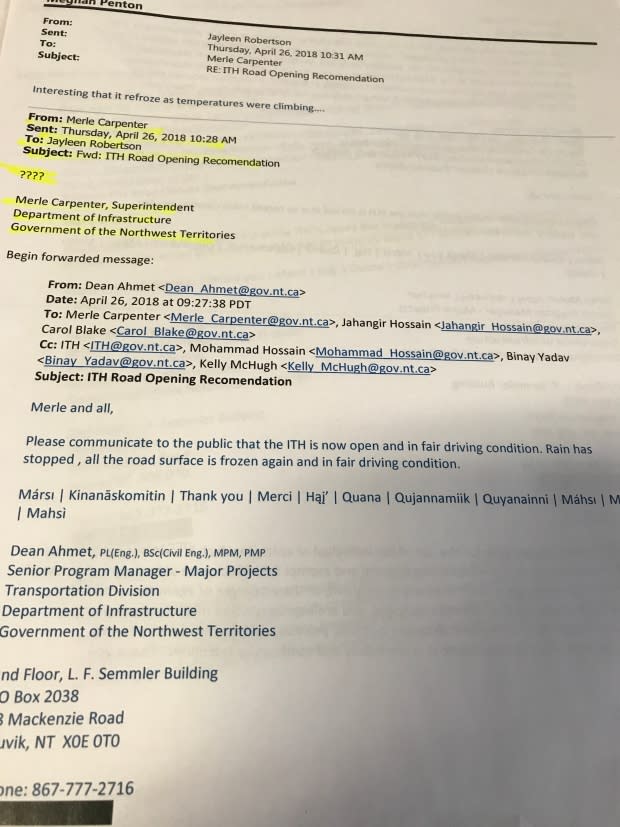Emails show communication breakdown over spring closure of Inuvik Tuktoyaktuk Highway
The N.W.T.'s Department of Infrastructure left the Inuvik Tuktoyaktuk Highway open for over 12 hours after an assessment in April deemed it should close due to thawing temperatures, an Access to Information request has revealed.
"It seems there was a communications breakdown today," wrote a department spokesperson on the morning of April 26, the day of the closure.
This email is one in a long chain of correspondence obtained by CBC News under Access to Information legislation that show the highway was open for about 12 hours after an assessment deemed it should close, followed by a short closure and subsequent reopening that sowed confusion within the department.
On the evening of April 25, the correspondence shows Dean Ahmet, senior program manager for the department, received an email saying road conditions were deteriorating due to rainfall and the highway should close. The sender of the email was redacted in the copy provided to CBC.
However, the email landed in Ahmet's junk folder, and nobody saw it until the next morning.

"It was after 6:00 p.m. and we were not in the office but available on our cells," he stated in an email to a colleague.
"Normally the contractor's operations and maintenance contact … always made sure we got his message. In this case he was out of town with no co-ordination of their contingency plans with us beforehand."
The department notified the public about the closure at about 8 a.m. the next day, before re-opening the road at about 10:40 a.m.
At about 10 a.m., Merle Carpenter, the superintendent for the department in the Inuvik region, sent an email to one of his colleagues that just said: "????"
He was writing in response to a subsequent message from Ahmet advising the highway had reopened. As Carpenter was gearing up for a media interview on road conditions that morning, his colleagues were scrambling to determine the status of the road.
Later that morning, Kevin McLeod, assistant deputy minister for the Department of Infrastructure, wrote to his colleagues: "We should once again review and update how this information is transmitted in an effective manner."
He then wrote to Ahmet, who sent the email saying the road had reopened: "[The highway] needs to be a joint plan not just your plan."
A fragile road

The Inuvik Tuktoyaktuk Highway, a $300 million joint project between the federal and N.W.T. governments, opened in November 2017.
It boasts a state-of-the-art design that is meant to protect the fragile permafrost below. Keeping traffic off the highway during wet, muddy conditions is not only a safety issue for the public, but essential to protect the integrity of the road itself.
That said, in an interview with CBC last week, McLeod stressed that the decision to close the road is one his team doesn't take lightly, and defended the way things rolled out April 26.
"I don't think there was any breakdown [in communication]," he said. "I think you are potentially misreading things. These are internal documents of folks trying to gain information."
How to close a highway
The protocol to close a highway in the N.W.T. works like this: somebody — perhaps RCMP, a contractor, or a traveller — will report something, whether that be an accident, wildfires or muddy, slippery conditions.
The department will then do an assessment and if needed, the regional superintendent and his or her team will make the call to close the road.
It is vital that Dean and Merle and the region are joined at the hip on all these things. - Kevin McLeod, assistant deputy minister, Infrastructure
But the Inuvik Tuktoyaktuk Highway was still under construction this spring. That means the contractor, in partnership with the department, was managing the status of the highway.
Thus, according to McLeod in an email from April 27: "it is vital that Dean [Ahmet] and Merle [Carpenter] and the region are joined at the hip on all these things — I do not want to see any emails that come from Dean that [are] not fully co-ordinated with the region."
When asked whether the department has reviewed the way information is shared internally about road closures, McLeod said the department updates their protocols "all the time."
However, when he was asked what's changed since this spring, he said the protocols are "exactly the same."
Infrastructure spokesperson Greg Hanna said the communications arm of the department keeps a person on call at all times to alert the public of road closures and re-openings.
"That underscores our commitment to getting information out in a timely way," he said.
Emails show call for better highway barriers
When the road is closed, the department places temporary barriers across the entrance.
But during this spring melt, officials in the department expressed concern that people were simply driving around the barriers to get onto the Inuvik Tuktoyaktuk Highway.
On May 16, Carpenter wrote that his team was looking to install lockable gates to solve this issue.
"These gates are being considered for the safety of the travelling public for storms that are encountered in the winter months," he wrote.
"We are also looking to protect the integrity of the highway during the rainy shoulder seasons in the spring and fall, which is causing quite a bit of damage to the highway."
The barriers were never installed, according to the department's assistant deputy minister, Jayleen Robertson.
In fact, the department doesn't use permanent gates at all to close territorial highways.
"[It's] essentially a safety hazard to have a locked gate on a closed highway because we may have travellers that may get trapped in between, inside the closed highway," she said.
Robertson said the department relies on the public to simply obey the signs, and warned that anybody caught driving on a closed road in the N.W.T. could face a fine of more than $800.

